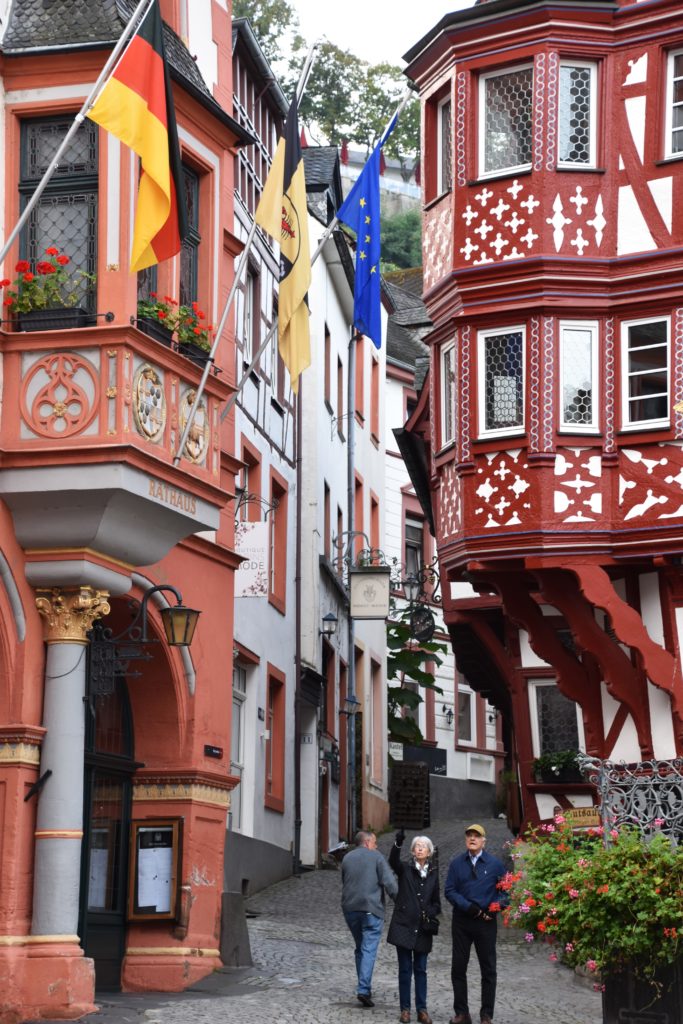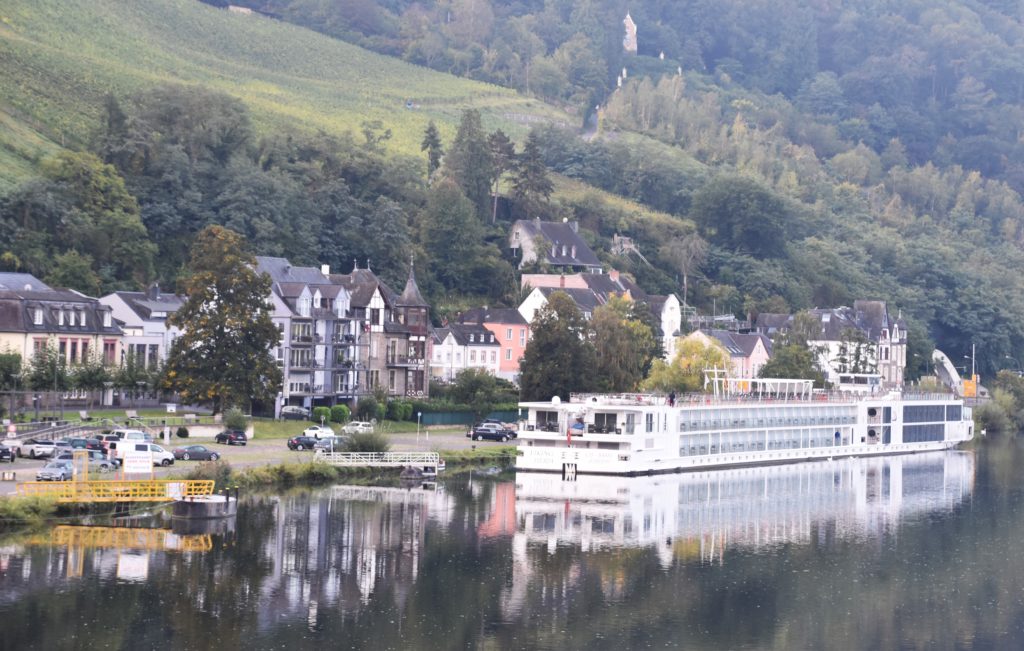MARILYN JONES is on board a Viking River Cruise along the Rhine
 Bernkastel-Kues, Germany
Bernkastel-Kues, GermanyI AM travelling in the Longship Freya, moored in Basel, Switzerland. The ship accommodates 190 guests and 53 crew members.
My stateroom is spacious, with a veranda for watching little villages, vineyards, and wildlife pass by.
The ship is classic Scandinavian, with lots of blonde wood and simplicity. It is peaceful and elegant, the perfect surroundings to relax.
Every evening, just before dinner, the cruise director tells guests what the next day's activities will be, from included excursions to optional ones. After dinner the ships complement is entertained by locals who step onto the longship from their home port to present music and lectures.
Sailing the Rhine
Our first stop along the Rhine River is Strasbourg with equal parts French and German culture. The city dates back to a Roman camp, first mentioned in 12 BC.
Canals crisscross our path, and we pass the Old Customs House and the bridges with their defensive towers. Tour highlights include Rhineland's black and white timber buildings and the sandstone Cathedral Notre-Dame of Strasbourg. It is one of Europe's finest Gothic cathedrals. It was the world's tallest building from 1647 to 1874.
The astronomical clock in the cathedral is the third on that spot and dates from the time of the first French possession of the city (1681–1870). The first clock dates to the 14th century, and the second in the 16th century. The current clock features a perpetual calendar, a planetary dial, a display of the actual position of the Sun and the Moon, and solar and lunar eclipses. The main attraction is the procession of the 18-inch-high figures of Christ and the Apostles, which occurs every day at solar noon, while the life-size cock crows thrice.
Speyer, founded by the Romans, features the largest Romanesque imperial cathedral. Protestants earned their name here in 1529 after citizens and royalty drafted the "Protestation at Speyer," proclaiming their right to practise Christianity as they please.
Speyer also claims to be the originator of the German pretzel. So naturally I have one as I walk along the main street.
Mainz, Germany, has two highlights: the Mainz Cathedral, a soaring landmark more than 1,000 years old with six magnificent towers, and the Gutenberg Museum dedicated to the inventor of movable type and book printing.
We stroll by mediaeval houses and storefronts before entering the Romanesque cathedral.
I enjoy the museum honouing the genius of Johannes Gutenberg. A local guide shows us how Gutenberg used his printing press to create the famous Gutenberg Bible. The detailed process would forever change how we exchange information and knowledge.
On view is a copy of the Gutenberg Bible. A fascinating look at the past.
On our way to Koblenz, Germany, we sail through the Middle Rhine and cruise through the Rhine Gorge, a UNESCO World Heritage Site, past castles on both sides of the river. The cruise director tells us about each castle as we sail by.
Koblenz, established as a Roman military post by Drusus around 8 B.C., is located at the confluence of the Rhine and Moselle rivers. Known as the "German Corner," it symbolizes the unification of Germany and features an equestrian statue of Emperor William I.
 Viking Freya docked in Bernkastel, Germany
Viking Freya docked in Bernkastel, GermanyMoselle River
Our cruise now follows the Moselle River to Cochem, Germany, and the Reichsburg Castle perched on a hill overlooking the town.
I venture out to explore Bernkastel-Kues, Germany, just after sunrise. I have several hours to walk through this mediaeval town on the Moselle River. It's Sunday. Church bells, dog walkers, and residents hurrying to bakeries for their breakfast greet me as I stroll city streets.
I am sailing with Viking River Cruises, and we are docked right in town.
The community, known for its wine production, is the site of an optional tour for onboard wine enthusiasts — or you can take the tour on your own.
My favourite area is the mediaeval marketplace with its gabled timber-frame houses from the 17th century and the narrow Spitzhäuschen ("Pointed House") from 1416. Around Saint Michael's Fountain, dating from 1606, are a row of well-preserved buildings and the Renaissance Town Hall from 1608.
Later, our guide takes us on a 1,000-year castle journey. In 1151, King Konrad III occupied the castle. In 1688, the castle was overrun by French King Louis XIV's troops during the Nine Years' War. The following year, the French destroyed it. The castle complex long lay in ruins. In 1868, it was bought by the Berlin businessman Louis Fréderic Jacques Ravené for 300 Goldmark and then reconstructed in the Gothic Revival style.
The tour includes several rooms with original furnishings, artwork, and decor from when the businessman lived here more than a century ago.
The walking tour in town is also excellent and offers the history of this city of 5,000 settled in 866. Features included the medieval town gate and various churches, including the 15th-century St. Martin's Church, the market square, and the 17th-century Capuchin Monastery,
Trier
The ship now sails to Trier, Germany's oldest city. Vestiges of Rome's power is everywhere, seamlessly mingling with a vibrant and active modern city. The Roman city gate, a UNESCO World Heritage Site, once served as the formidable entrance to the town.
The Cathedral of Trier, built under the direction of Helena, mother of Emperor Constantine, and the Church of Our Lady, one of the earliest Gothic churches in Germany, stand side by side.
Several monuments and cathedrals are UNESCO World Heritage Sites because of their significance during the Roman and Holy Roman empires.
On our motor coach trip to Paris, we stop at the Luxembourg American Cemetery and Memorial, where 5,073 US soldiers who died in the Battle of the Bulge, and General George S. Patton, are laid to rest.
Our journey continues to Reims, France, and a visit to the Reims Cathedral, a UNESCO World Heritage Site. The Gallery of Kings features an imposing sight composed of 56 statues standing above the central portal and stunning stained-glass windows dating from the 13th through 20th centuries, including windows designed by Marc Chagall.
Our final destination, Paris, includes a motor coach and a walking tour with all the highlights of the City of Lights including Arc de Triomphe, Eiffel Tower, and Notre-Dame.
This is Viking River Cruises: castles, cathedrals, and mediaeval communities; beautiful accommodations, excellent food, and an accommodating crew. This is culture, history, and fun.
For more information: www.vikingcruises.co.uk

